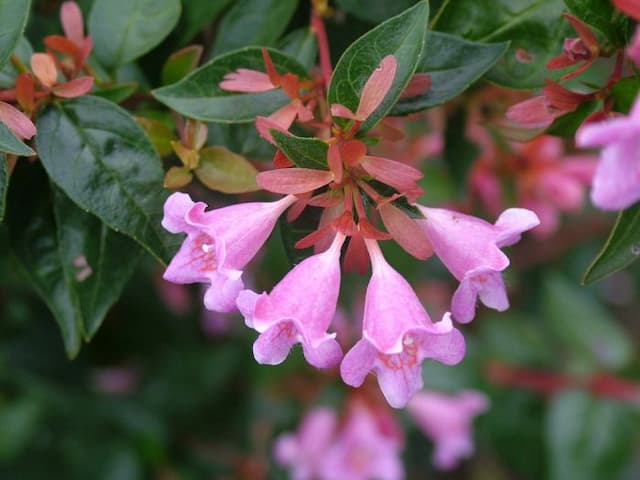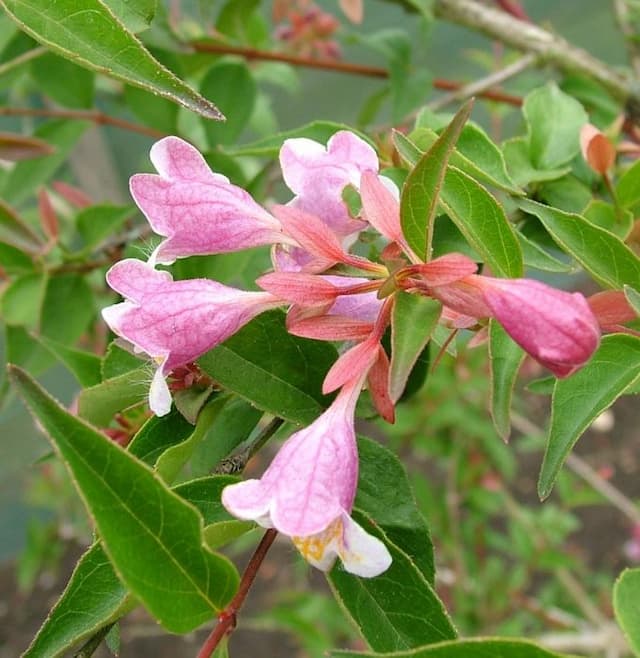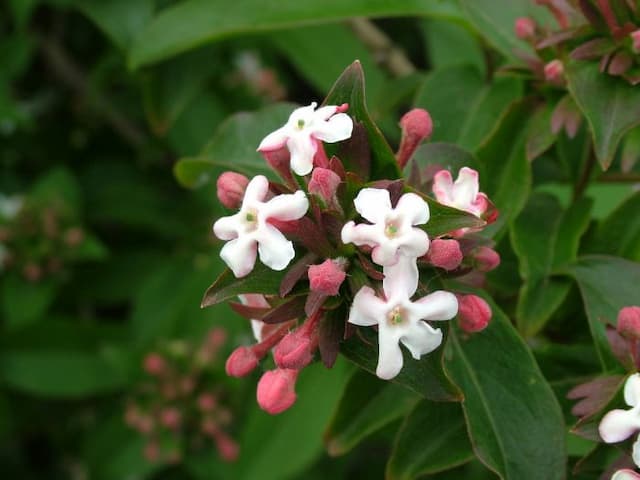Pincushion flower Scabiosa atropurpurea 'Summer Berries'

ABOUT
The Scabiosa atropurpurea 'Summer Berries' is a charming flowering plant that is popular for its visually striking flowers. Commonly known as the pincushion flower, this plant boasts a rich tapestry of warm colors, with blossoms that range from deep burgundy and red to soft pinks, lavenders, and even occasional whites. These vivid flowers are shaped like pincushions, featuring a compact center that is surrounded by an array of thin, spiky petals that give it a frilly, whimsical appearance. The pincushion flower produces numerous flower heads that are held above a mound of softly textured, gray-green foliage. The leaves of the plant are oblong and slightly lobed, adding to the delicate texture of the overall plant. The bloom season for the 'Summer Berries' variety is especially long, offering continuous color from early summer well into the fall. The combination of the pincushion flower's distinct flower heads and the mix of warm colors creates an alluring effect in any garden setting, making it a favorite among gardeners and flower enthusiasts. It is not only attractive to the human eye but also appeals to a variety of pollinators such as bees and butterflies, making it a beneficial addition to any outdoor space. The blossoms of Scabiosa atropurpurea 'Summer Berries' can also be used for cutting, allowing the vibrant flowers to be brought indoors to adorn vases and floral arrangements.
About this plant
 Names
NamesFamily
Caprifoliaceae
Synonyms
Pincushion Flower, Mourning Bride
Common names
Scabiosa atropurpurea.
 Toxicity
ToxicityTo humans
The pincushion flower, specifically Scabiosa atropurpurea 'Summer Berries', is not commonly known to be toxic to humans. However, as with many plants, individuals may experience varying degrees of sensitivity, such as a mild skin irritation or an allergic reaction upon handling or touching the plant. Ingesting parts of the plant is not advisable since it may lead to gastrointestinal discomfort or other negative reactions in some people. In the absence of widespread reports of serious toxicity, the plant is generally considered to have a low risk of poisoning when touched or ingested in small quantities.
To pets
The pincushion flower is not commonly listed as a toxic plant for pets. However, each pet may react differently, and some might experience mild gastrointestinal upset if they ingest parts of the plant. Common symptoms of mild plant toxicity in pets can include vomiting, diarrhea, drooling, or loss of appetite. It is always advisable to prevent pets from ingesting plants, as they might have individual sensitivities or allergies. If you suspect your pet has ingested a significant amount of the plant and is showing symptoms of distress, contact your veterinarian.
 Characteristics
CharacteristicsLife cycle
Annuals
Foliage type
Deciduous
Color of leaves
Green
Flower color
Mixed
Height
2-3 feet (60-90 cm)
Spread
1-1.5 feet (30-45 cm)
Plant type
Herb
Hardiness zones
9
Native area
Mediterranean
Benefits
 General Benefits
General Benefits- Attracts pollinators: The vibrant blossoms of the Pincushion Flower draw in bees, butterflies, and other beneficial insects, which are vital for pollination.
- Easy to grow: It is known for being a low-maintenance plant that can thrive in a variety of conditions, making it suitable for amateur gardeners.
- Long blooming period: The Pincushion Flower has a lengthy flowering season, often from early summer to fall, providing extended color and interest in the garden.
- Great for cut flowers: The flowers have long stems and a unique appearance, making them excellent for use in fresh bouquets and floral arrangements.
- Versatile garden use: They can be planted in borders, beds, rock gardens, and containers, offering a high degree of versatility in landscape design.
- Drought-resistant: Once established, these plants are quite drought-tolerant, requiring minimal water and care in dry conditions.
- Deer resistant: The Pincushion Flower is not a favorite of deer, reducing the likelihood of damage in areas where deer browsing can be a problem.
- Wide range of colors: The 'Summer Berries' variety offers a mix of berry tones, from deep burgundy to soft pinks, adding a diverse palette to the garden.
 Medical Properties
Medical PropertiesThis plant is not used for medical purposes.
 Air-purifying Qualities
Air-purifying QualitiesThis plant is not specifically known for air purifying qualities.
 Other Uses
Other Uses- Dye Production: The deep hues of the Scabiosa atropurpurea 'Summer Berries' flowers can be used to create natural dyes for fabric or other crafts.
- Ink Making: Similarly, the pigments from the pincushion flower can be used to make natural inks for art and writing.
- Photography: The striking appearance of the pincushion flower makes it an excellent subject for botanical photography.
- Edible Decorations: The petals of Scabiosa atropurpurea 'Summer Berries' can be used to add color and interest to culinary presentations, though they should be used sparingly and ensure that they are free from pesticides.
- Eco-printing: Leaves and flowers can be used in eco-printing, a technique where plants are used to leave natural prints on fabric or paper.
- Companion Planting: Pincushion flowers can be used in the garden to attract pollinators, which are beneficial for the growth of vegetables and fruits.
- Crafts: Dried Scabiosa atropurpurea 'Summer Berries' blooms can be incorporated into wreaths, dried flower arrangements, or potpourri mixes.
- Flower Confetti: Dried petals of the pincushion flower can be used as biodegradable confetti for celebrations and weddings.
- Bookmarks: Pressed flowers of the Scabiosa atropurpurea 'Summer Berries' can be laminated or placed inside clear bookmarks for a decorative touch.
- Floral Water: The fragrance of the flowers might be infused into water to create lightly scented floral waters for linen sprays or room fresheners.
Interesting Facts
 Feng Shui
Feng ShuiThe Pincushion Flower is not used in Feng Shui practice.
 Zodiac Sign Compitability
Zodiac Sign CompitabilityThe Pincushion Flower is not used in astrology practice.
 Plant Symbolism
Plant Symbolism- Admiration: Scabiosa, also known as Pincushion Flower, is often associated with admiration due to its unique, intricate blossoms that seem to invite a closer look, almost demanding a gaze of respect and fascination.
- Love: The Pincushion Flower is a symbol of love and can represent both unrequited love and pure love. The flower’s variety of colors and delicate form contribute to its romantic symbolism.
- Beauty: With its stunning and diverse hues, the 'Summer Berries' variety specifically brings to mind the beauty of nature in summertime, and it may be given as a compliment to someone's aesthetic allure.
- Loneliness or Longing: In the language of flowers, Scabiosa can evoke a sense of longing or pining for someone, as it symbolizes a deep desire that is as persistent as the plant’s long blooming period.
 Water
WaterPincushion Flower requires regular watering to maintain consistent soil moisture. Water deeply once a week, providing about one inch of water each time, which roughly translates to about 0.6 gallons per square foot. During hot or dry spells, increase the frequency to twice a week. Always check the top inch of soil; if it feels dry to the touch, it's time to water. Ensure that the soil drains well to prevent waterlogging, as Pincushion Flower does not like to sit in soggy soil.
 Light
LightPincushion Flower thrives in full sun conditions, receiving at least six hours of direct sunlight daily. An ideal spot for this plant would be in a south-facing garden that enjoys ample sunlight throughout the day. However, in regions with very hot summers, a location with partial afternoon shade can help protect the flowers from intense heat.
 Temperature
TemperaturePincushion Flower prefers moderate temperatures and grows best when daytime temperatures are between 60 and 75 degrees Fahrenheit. They can tolerate temperatures down to about 40 degrees Fahrenheit but should be protected from frost. Ensure a suitable microclimate that avoids extreme temperature fluctuations for optimal growth.
 Pruning
PruningPincushion Flower benefits from regular deadheading to encourage continued blooming. Prune spent flowers as soon as they fade, cutting them back to the base of the flowering stem. Perform a more thorough pruning to shape the plant and remove dead or damaged stems in early spring before new growth begins.
 Cleaning
CleaningAs needed
 Soil
SoilThe Pincushion Flower, or Scabiosa atropurpurea 'Summer Berries', thrives best in slightly alkaline to neutral soil with a pH of around 6.5 to 7.0. A well-draining soil mix with compost, loamy soil and a bit of sand is ideal. It's beneficial to enrich the soil with organic matter to promote healthy growth.
 Repotting
RepottingPincushion Flowers generally do not require frequent repotting. It is often repotted once it outgrows its current container or when the soil is depleted of nutrients, which may be every 2 to 3 years.
 Humidity & Misting
Humidity & MistingThe Pincushion Flower is quite adaptable and does not require high humidity levels. Average room humidity is typically sufficient for its growth.
 Suitable locations
Suitable locationsIndoor
Ensure bright light, well-draining soil, and moderate watering.
Outdoor
Plant in full sun, well-drained soil, protect from harsh winds.
Hardiness zone
4-10 USDA
 Life cycle
Life cycleScabiosa atropurpurea 'Summer Berries', commonly known as the Pincushion Flower, begins its life as a seed, which, when sown in spring after the last frost, germinates in warm soil. Upon germination, it develops a rosette of leaves at the soil surface, from which a root system establishes to support future growth. The plant then advances to the vegetative stage, growing stems and more leaves in preparation for blooming. Flowering generally occurs in late spring to summer, presenting a profusion of pincushion-like blooms that come in shades of red, pink, and purple, attracting pollinators such as bees and butterflies. After pollination, seeds form and mature within the flower heads, eventually drying and releasing seeds for dispersal. The Pincushion Flower may behave as a biennial or short-lived perennial, potentially going through several flowering cycles before the plant completes its lifecycle and dies.
 Propogation
PropogationPropogation time
Spring to Summer
Propogation: Scabiosa atropurpurea 'Summer Berries', commonly known as Pincushion Flower, is commonly propagated through seed. The best time to sow these seeds is either in early spring or late winter, indoor in starter pots, or directly into the garden after the last frost when the soil has warmed. To propagate Pincushion Flower by seed, simply scatter the seeds over moist soil and lightly cover them with a fine layer of soil, no more than 1/8 inch deep. Ensure the soil remains moist until germination, which typically occurs in 2 to 3 weeks. Seedlings can then be thinned or transplanted to their final positions, ensuring a spacing of about 12 to 15 inches between plants to allow for proper growth and air circulation.







![Himalayan honeysuckle [Golden Lanterns]](/_next/image?url=https%3A%2F%2Fplants-admin.emdemapps.com%2Fimages%2Fplants%2F%2Fimages%2F604b55302cc87.png&w=640&q=75)

